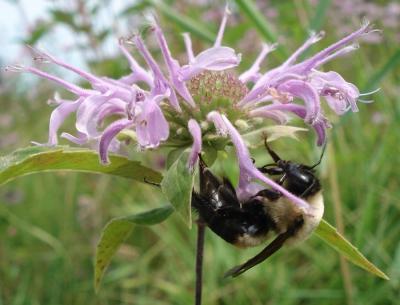
Pollinators move pollen from one plant to another, making them essential to plants and flowers that require pollination to reproduce. Such plants include the familiar fruits and vegetables we consume and the flowers we enjoy. While many people are very familiar with European honeybees, a non-native pollinator that humans introduced to North America, many native pollinators are equally as important.
Native species, unlike non-native species, naturally occur within a given area without human introduction. Some native plants rely solely on native pollinators to reproduce because introduced pollinators are unable to pollinate them. Habitat restoration can be significant to reversing a decline in native pollinators and to the future survival and the continued biodiversity of both native plants and pollinators.
The Pollinator Task Force is working to conserve bees and other Great Lakes native insect pollinators. In 2020, the U.S. Fish and Wildlife, through a cooperative agreement with Muskegon Conservation District, began restoration of approximately 155 acres of black oak barren in Michigan.
Black oak barren is a savanna type area dominated by oaks that is usually found southern Lower Michigan. These areas can support a wide variety of species including butterflies and birds. However, a significant number of these important habitat areas have become fragmented and degraded. This restoration project is a multiyear phase project which includes monitoring, soil scarification and seeding which will result in approximately 500 areas of savanna and barren communities restored with the potential for more. Soil scarification is the process of preparing an area to make it more accessible to seeds and promote seed germination. The improvement of this habitat will benefit endangered pollinators such as the Karner blue butterfly and monarch butterfly in addition to providing other ecological and environmental benefits. Planning is underway to restore 600 acres of habitat in 2021 and an additional 2,900 acres by 2023.
Pollinator Task Force collaboration has resulted in establishing more comprehensive native bee surveys on federal lands and neighboring habitats. The first year of these surveys was marked by the discovery of a cuckoo bee (Epeoloides pilosulus) population in the Chequamegon-Nicolet National Forest in 2019. The cuckoo bee (so named because it lays eggs in the nests of other bees, similar to the behavior of the cuckoo bird) is one of the rarest bees in North America.
This summer the GLRI Pollinator Task Force will continue native bee surveys on federal lands and finish identifying bee specimens with the University of Minnesota Bee Lab. Other plans include development of additional community outreach and education about the significance of native pollinators and their habitats throughout the Great Lakes Basin.
The GLRI Pollinator Task Force is a collaborative effort supported by the GLRI and led by U.S. FWS. Formed in 2017, the Pollinator Task Force brings together staff from U.S. Forest Service, National Park Service, U.S. Geological Survey, and Natural Resources Conservation Service with the goal of conserving native insect pollinators by increasing populations, restoring habitat, and increasing public awareness of pollinator conservation issues and efforts throughout the Great Lakes Basin. Other partners, such as Michigan State University, Michigan Natural Features Inventory and University of Minnesota Bee Lab, work with the Task Force to advance native bee research, bee identification and development of tools for focus area analysis and habitat restoration site selection.


